Environment And Health Definitions
Garbage
Garbage means discarded vegetable matter from kitchens, canteens, etc.
Sullage – Refers to fluid waste from a kitchen unmixed with excrement
Water sewage – Refers to wastewater from households, industries, etc containing human excreta
Refuse – Refuse is all solid and semi-solid waste matters of a community except excrement
Breakpoint chlorination
The point where the addition of chlorine to water results in the appearance of free residual chlorine is called break-point chlorination
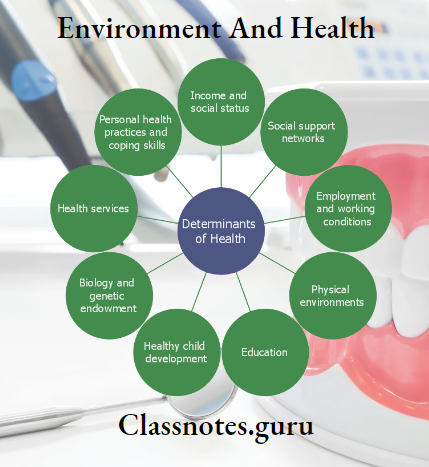
Environment And Health Questions And Answers
Environment And Health Important Notes
1. Biological wastes
Categories Of Biomedical Wastes

Color Coding
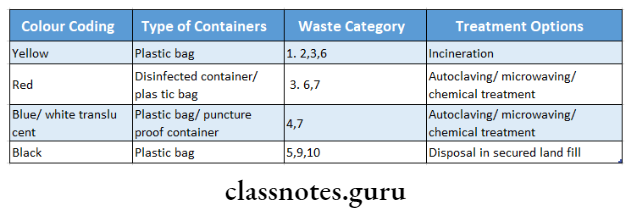
Read And Learn More: Percentive Communitive Dentistry Question And Answers
2. Methods of disposal of solid wastes
- Dumping – Refuse is dumped in low-lying areas
- Controlled tipping- Material is placed in a trench
- Incineration- It is the best method for the disposal of healthcare
- Composting- It is the process of nature where matter breaks down under bacterial action resulting in the formation of humus-like material called compost
- Manure pits- Manure pits are dug by individual householders to dump the garbage
- Burial – A trench is excavated and at the end of each day the trench is filled with earth and compacted
3. Composting is a method wherein sludge is combined with solid wastes to produce manure-quality material
- There are two commercial methods of composting
1. Bangalore method
- Bangalore method is a natural hot fermentation process in which trenches are dug and filled alternatively with refuse and excreta
2. Mechanical method
- The mechanical method involves pulverization of raw materials and mixing them with sludge.
4. Incineration
- Incineration is a high-temperature dry oxidation process that reduces organic and combustible waste to inorganic, incom- combustible matter resulting in a significant reduction of waste volume and weight
- Types
- Double-chamber pyrolytic incinerators
- Single chamber furnaces
- Rotary kilns
- Incineration is the choice of disposal for the following wastes
- Human anatomical waste
- Animal waste
- Microbiology and biotechnology waste
- Discarded medicines and cytotoxic drugs
- Contaminated solid wastes
- Wastes that should never be incinerated are
- Amalgams
- Latex gloves
- Lead wastes
- PVC plastics
Relationship Between Environment And Health
5. Loss of head
- As filtration proceeds, the suspended impurities and bacteria clog the filters and they soon become dirty and
- begin to lose their efficiency
- This is known as loss of head
- When the loss of the head approaches 7-8 feet, filtration is stopped and subjected to backwashing.
Environment And Health Long Essays
Question 1. Describe in detail the small-scale purification.
Answer:
Small-Scale Purification:
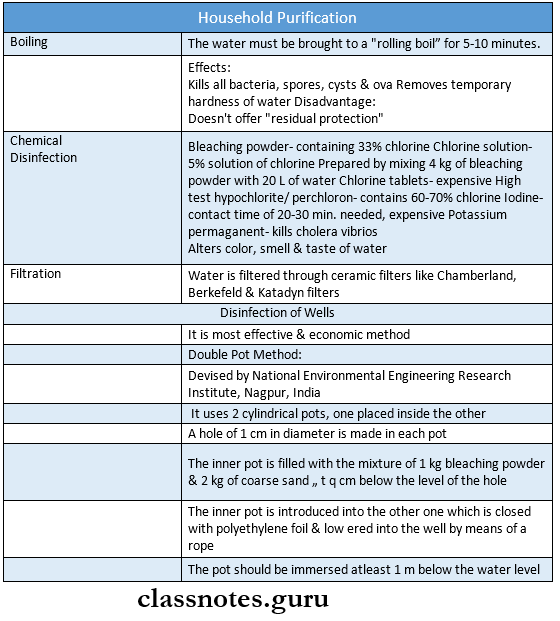
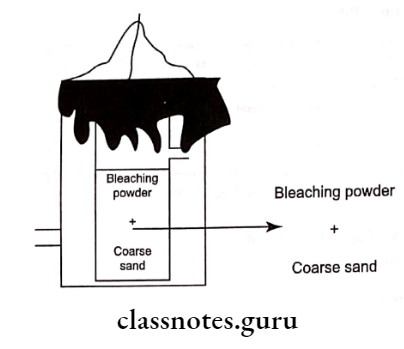
Environment And Health Short Essays
Question 1. Principles of chlorination.
Answer:
Principles Of Chlorination
- The water to be chlorinated should be clear & free from turbidity
- The chlorine demand of the water should be estimated
- The point at which the chlorine demand of the water is met is called the “breakpoint”
- If further chlorine is added, free chlorine begins to appear in the water
- The free residual chlorine should be present for a contest 1 hour to kill bacteria & viruses
- The minimum recommended concentration of free. It is defined as water that is chlorine is 0.5 mg/L for 1 hour
- The correct dose of chlorine to be applied = chlorine de- mand of water + free residual chlorine.
Question 2. Occupational hazards for dentists.
Answer:
Occupational Hazards For Dentists
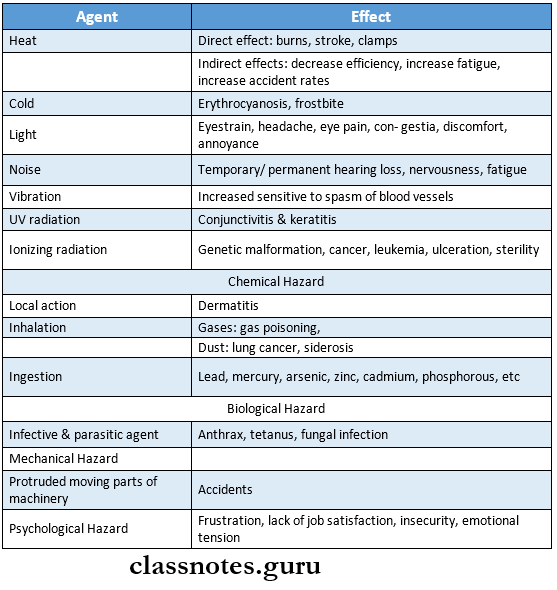
Question 3. Potable water.
Answer:
Potable Water
- Potable water is defined as water that is
- Free from pathogens
- Free from harmful chemicals
- Pleasant to taste
- Usable for domestic needs
- Potable Water Requirements:
- Must be close to the people as its transportation may lead to pollution
- The basic requirement at about 2 L/head/day
- A daily supply of 150-200 L/capita is considered adequate to meet the domestic needs of the urban population
- Potable Water Uses
- Domestic purposes: drinking, cooking
- Public purposes: cleaning streets & fire protection
- Industrial purposes: factories
- Agricultural purposes: irrigation
Impact Of Environment On Human Health
Question 4. Disposable of hospital waste.
Answer:
Hospital Waste Dumping:
- Waste/refuse is dumped in low-lying areas
- Hospital Waste Dumping is a suitable method for the reclamation of land
- As a result of bacterial action, refuse decreases consist of each day the erably in volume and is converted gradually into humus
Hospital Waste Controlled Tipping:
- Here, the material is placed in a trench or other pared area, adequately compacted and covered with earth at the end of the working day
Hospital Waste Trench Method:
- A long trench is dug out 6-10 feet deep & 12-36 feet wide into which refuse is compacted & covered with caveated earth
- Ramp method
- Moderately sloping terrain is used Area method
- The refuse is deposited & sealed on its exposed face with a mud cover
- Changes occurring in refuse raise the temperature to 60 degrees C within 7 days & kill all the pathogens
Hospital Waste Incineration:
- By it, the refuse is reduced to 1/4th its original weight & the residue is called “clinker” and used for road making
- The incinerator consists of:
- A furnace
- A platform: for tipping refuse
- Baffle plate: to drive out all fumes
Hospital Waste Types:
- Double cell Meldrum
- Single-cell destructor
Hospital Waste Composting:
- It is a process of nature where matter breaks down under bacterial action resulting in the formation of relatively stable humus-like material called compose
- The compost formed contains few or no disease-producing agents
- The heat produced destroys all pathogens
Hospital Waste Manure pits
- Dug by individual householders to dump garbage& other waste & covered with earth after each day’s dumping
Environmental Health Hazards
Question 5. Rapid sand filtration.
Answer:
Rapid Sand Filtration
Rapid Sand Filtration Types:
- Gravity type
- Pressure type
Rapid Sand Filtration Steps:
Coagulation:
- Raw water is first treated with chemical coagulants such as alum
Rapid Mixing:
- The water is then violently agitated in a “mixing chamber” for a few minutes
Flocculation:
- It involves slow and gentle stirring of treated water in a “flocculation chamber” for 30 minutes
Sedimentation:
- The water is then led into sedimentation tanks & kept for 2-6 hours
Filtration:
- The water is then subjected to filtration
Question 6. Composting.
Answer:
Composting Methods:
Bangalore/Anaerobic/ Hot Fermentation Process:
- Trenches are dug 3 feet deep, 5-8 feet broad, 15-30 feet long & located at least 800 m away from the city limits
- First, a layer of refuse is spread followed by nightsoil
- Similarly, alternate layers of refuse & nightsoil are added till the heap rises 1 foot above the ground level
- The top layer should be of refuse, at least 9 inches in thickness which is covered with excavated earth & compacted
- Within 7 days, considerable heat is generated which persists over 2-3 weeks
- Duration: 4-6 months
- Result
- The resulting material is a well-decomposed, odorless, nocuous material of high-manured value
Mechanical/ Aerobic Method:
- The refuse is first cleared of salvable material
- Then pulverized in pulverizing equipment
- The pulverized refuse is then mixed with sewage, sludge, or night soil in a rotating machine & incubated
- Duration: 4-6 weeks
Types Of Environmental Pollution
Question 7. Elements of a slow sand filter.
Answer:
Supernatant Water:
- Depth: 1-1.5 m above the sand bed
- Purposes
- Provides constant head of water
- Provides a waiting period of some hours for the raw water
A Bed of Graded Sand:
- Thickness: about 1 m
- The sand bed is supported by a layer of graded gravel
- Water percolates through the sandbed very slowly
- Then it is subjected to mechanical straining, sediments bacterial action
Under Drainage System:
- Consist of porous/ perforated pipes
- Purpose
- Provides an outlet for filtered water
- Support filter medium above
Filter Control:
- Filter Control maintains a constant rate of filtration
- The venturi meter is used to measure the loss of head/ bed resistance
- When the resistance builds up the operator opens the regulating valve to maintain a steady rate of filtration
Question 8. Incineration
Answer:
Incineration
- Incineration is a high-temperature dry oxidation process that duces organic and combustible waste to inorganic, combustible matter resulting in a significant reduction of waste volume and weight
Incineration Types
- Double-chamber pyrolytic incinerators
- Single chamber furnaces
- Rotary kilns
- Incineration is the choice of disposal for the following wastes
- Human anatomical waste
- Animal waste
- Microbiology and biotechnology waste
- Discarded medicines and cytotoxic drugs
- Contaminated solid wastes
- Wastes that should never be incinerated are
- Amalgams
- Latex gloves
- Lead wastes
- PVC plastics
Environment And Health Short Question And Answers
Question 1. Compositing.
Answer:
Compositing
- Compositing is a process of nature where matter breaks down un- der bacterial action resulting in the formation of relatively stable humus-like material called compose
- The compost formed contains few or no disease-producing agents
- The heat produced destroys all pathogens
- By-products: carbon dioxide, water, heat
Methods: Bangalore method, mechanical composting
Air Pollution And Health Effects
Question 2. Backwashing.
Answer:
Backwashing
- Rapid sand filters need frequent washing daily/weekly depending upon the loss of head
- Washing is accomplished by reversing the flow of water through the sand bed-back washing
- Washing is stopped when the wash water is sufficiently clean
- Compressed air is used
Backwashing Effects:
- Dislodges the impurities
- Cleans the sand bed
Duration of Process: 15 minutes
Question 3. Loss of head.
Answer:
Loss Of Head
- When the filtration proceeds the suspended impurities & bacteria clog the filter
- This results in their reduced efficiency called “loss of head”
Loss Of Head Effects:
- Filters soon become dirty
- When “loss of head” approaches 7-8 feet, filtration is stopped
- Filters are subjected to backwashing
Question 4. Vital layer.
Answer:
Vital Layer Definition:
- The vital layer is the slimy growth covering the surface of the sand bed
Vital Layer Synonym:
- Schmutzdecke, zoogleal layer, biological layer
Vital Layer Components:
- Threadlike algae
- Plankton
- Diatoms
- Bacteria
Vital Layer Formation:
- Vital layer formation of the vital layer is known as the “ripening” of Disadvantages: filter
- The vital layer takes several days the form
Vital Layer Significance:
- The vital layer is the heart of the slow sand filter
- Removes organic matter
- Holds back bacteria
- Oxidizes ammonical nitrogen into nitrates
- Purifies water
Question 5. Breakpoint chlorination.
Answer:
Breakpoint Chlorination
- The fall in residual chlorine continues with a further increase in chlorine dose, until after a stage residual chlorine begins to increase in the proportion
- The point where the addition of chlorine to water results in the appearance of free residual chlorine is called breakpoint chlorination
- When the chlorine dose in the water is increased a reduction in the residual chlorine occurs
Water Pollution And Diseases
Question 6. The hardness of the water.
Answer:
The Hardness Of The Water Definition:
- The hardness of the water is defined as the soap-destroying power of water
Hardness Of The Water Causes:
- Calcium bicarbonate
- Calcium sulfate
- Magnesium bicarbonate
- Magnesium sulfate
Classification Of Hardness Of The Water:
- Carbonate/temporary hardness
- Non-carbonate/ permanent hardness
Hardness Of The Water Expressed as: milliequivalent/L
The Hardness Of The Water Removed as:
- Temporary hardness
- Boiling
- Addition of lime
- Addition of sodium carbonate
- Permutit process
- Permanent hardness
- Addition of sodium carbonate
- Base exchange process
Hardness Of The Water Disadvantages:
- Consumes more soap And detergent
- Causes furring of boilers
- Effects cooking
- Fabrics washed do not have a long life
- Results in economic losses
- Shortens the life of pipes & fixtures
Question 7. Sources of water.
Answer:
Sources Of Water
- Rain-main source
- Surface water
- Sources of water ultimately flow into the sea
- Impounding reservoirs- artificial lakes/ constructed dams
- Rivers and streams: grossly polluted and unfit for drinking
- Ponds and lakes: natural excavation
- Sea water: contains 35% of salts in solution
- Groundwater: formed by percolated rainwater
- Shallow wells: above the 1st impervious layer in the ground
- Deep wells: below the 1st impervious layer in the ground
- Tube wells: shallow/ deep, costly to construct & operate
- Springs: shallow/deep, easily contaminated
Question 8. Controlled tipping.
Answer:
Controlled Tipping
- Controlled Tipping
- Here, the material is placed in a trench or other pared area, adequately compacted and covered with earth at the end of a working day
- Methods
- Trench Method
- A long trench is dug out 6-10 feet deep and 12-36 feet wide into which refuse is compacted and covered with excavated earth
- Ramp method
- Moderately sloping terrain is used
- Area method
- The refuse is deposited & sealed on its exposed surface with a mud cover
- Changes occurring in refuse raise the temperature to 60 degrees C within 7 days and kill all the pathogens
Environmental Sanitation In Public Health
Question 9. Waterborne diseases.
Answer:
Waterborne Diseases
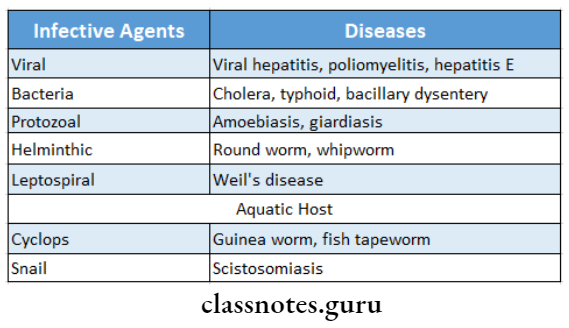
Question 10. Domestic refuse.
Answer:
Domestic Refuse
- Domestic refuse consists of ash, rubbish, and garbage
- Ash:
- Ash is the residue from the fire used for cooking and heating Rubbish:
- Comprises of wood bits, paper, clothing, metal, glass, dirt and dust
- Garbage:
- Garbage consists of waste food, vegetable peeling, and organic matter
- Garbage needs quick removal and disposal because it ferments on storage
Environment And Health Viva Voce
- The slimy growth covering the surface of the sand bed
- Rapid sand filter is an earlier method of filtration where 99.9% of impurities are filtered out.
- Clinical wastes are disposed of in yellow bags and non-clinical wastes are disposed of in black bags
- Incinerators are used to burn all the combustibles at a temperature of 1300-1500 degrees C
- Bangalore’s method of composting is anaerobic.
- Occupational hazards to dentists result from accidental infection
- Residual chlorine of water should be 0.5 mg/ltr after 1 hour
- The temporary hardness of water is due to the presence of salts of calcium and phosphorous bicarbonates
- Dumping is considered as most unsanitary method of waste disposal.
- Waste sharps from hospitals should be discarded in
- The heat produced over 60 degrees C in composting kills
- Composting is a combined method of disposal of re-fuse and nightsoil.
- Dumping is the most commonly used method of waste disposal posing a health hazard in India.
- The hardness of water is expressed in terms of oil- oil-equivalent per liter
- The permanent hardness of water can be removed by base blue/white translucent bins. exchange process
- Chlorination of water acts by killing pathogenic bacteria the pathogenic organisms.
- Rainwater is the purest form of water
